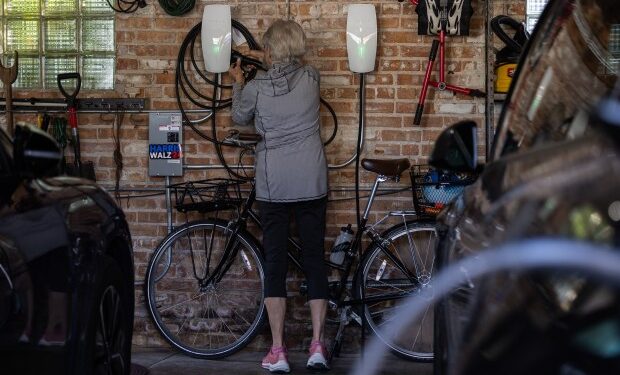Electric vehicles are all the rage at the four-unit brick building in McKinley Park where three generations of the Breems family live.
After years of encouragement from Joel Breems, the only sibling who does not live at the building, Kara Breems and her husband, Tony Adams, bought a Tesla Model Y in August. So did the other Breems sibling, Daniel, and his wife, Heather.
Not to be outdone, the siblings’ parents, Helen and Brad, took the plunge a few weeks later, bringing home a third EV, a royal blue Kia EV6.
“We’re all super-excited,” said Kara Breems, 48.
The Breems family is part of a good news-bad news story on EV sales that’s making for seemingly contradictory headlines, including one — “GM scales back EV plans” — that’s displayed prominently in an ad that Republican presidential candidate Donald Trump has been running in the key battleground state of Michigan.
Electric vehicles continue to grow in the United States but not at the pace of 2021 to 2022, when estimated annual increases were 89% and 65%, according to data from Cox Automotive, an automotive services and technology provider.
The 2023 annual increase was 46%, and in the most recent quarter of this year, year-over-year growth was about 11%.
The slowdown — fueled in part by customer concerns about cost and range — hasn’t stopped the United States, or Illinois, from setting new annual records for EV sales, including 1.2 million electric cars sold nationwide in 2023.
But it has created problems for auto manufacturers and dealers, including, at times, a surplus of cars in dealers’ lots, and it has forced some car companies to reconsider short-term goals.
GM, for instance, has delayed some aspects of its EV plan, including an electric Buick, but recently reiterated its commitment to sell only electric cars by 2035.
“You’re seeing delays” by car manufacturers,” said Andrew Loh, Boston Consulting Group managing director and senior partner.
“It’s not full-out cancellations, but they’re like, we need to go back to the drawing board a little bit to think about how we’re actually going to make these profitable, and once we’re ready, then we will launch our next generation (of vehicles).”
Analysts predict that sales will continue to grow but also point to customer concerns about price and range, or the distance a car can travel before it has to recharge.
A Boston Consulting Group survey of 3,000 consumers earlier this year found that 6% already own an EV, 38% intend to purchase an EV as their next vehicle, and another 27% are considering buying one in the future.
That suggests a big market, but an accompanying article co-authored by Loh said that while those who intend to purchase an EV aren’t that different from current EV owners, their expectations for price and performance are higher.
The potential purchasers’ median requirements included 20-minute charging times; 30-minute detour and wait times for charging on the road; a 350-mile driving range; and a price of $50,000.
The authors found that one car — the e Hyundai Ioniq 6 — was already meeting all of those criteria, with the popular Tesla Model 3 close behind.
The authors said that EV sales, which are now about 9% of the new vehicle market, could potentially reach 30% in the next few years — with more government support and a better charging network — but that 20% was a more realistic forecast.

Back in McKinley Park, Kara Breems said that cost was certainly one of the factors that family members considered.
“We’re all price-motivated,” Breems said with a chuckle.
The environment was a big motivator, she said, as was her brother Joel, an EV “evangelist,” who lives in Spokane, Washington, and kept the issue on the family’s agenda.
But Kara Breems also pointed to big financial incentives, including a ComEd program that allowed the family to get 2 EV chargers for free, thanks to their location in an “equity investment eligible community” — an area affected by underinvestment or disproportionate pollution.
Heather Breems, a social worker, had leaned toward the relatively affordable Chevy Bolt, which can cost less than $30,000 but took a closer look at the Tesla Model Y, with a price range of about $43,000 to $52,000, at the urging of her husband, Daniel, an exhibits production supervisor at a local museum.
Among the considerations: the couple have five school-age kids, three of whom play competitive soccer, and they spend a lot of time ferrying their children around the city.
Heather Breems went back and reviewed how much the family has spent on gas in recent years — about $4,000 to $4,500 a year — and realized an EV would pay for itself faster than she had expected.
Another consideration was that their home has solar panels — and the family intends to add more for charging. After energy savings pay for the panels, charging will basically be free.
A closer look at the Tesla price range also helped.
Heather Breems said she knew people who had Teslas and assumed they were paying luxury car prices.
“That’s not us,” she would say to herself. “We’re here in our used 2010 (Honda) Fit.”

Breems now sees the family Telsa as a great driving experience — and a sound financial decision.
“We probably should have (done) it a lot sooner,” she said.
Range anxiety is perhaps the best-known concern of potential EV drivers — a combination of concern about how far a car can go before recharging and how many public chargers are available.
And here, the picture is a bit more complex, with range increasing for many vehicles but public fast-charging remaining a challenge.
Janice and James Cha of Morton Grove bought their first all-electric car in September 2023: an ice-blue metallic Chevy Bolt EUV.
“Once we had it, my husband was working downtown and I would wake up early in the morning to drive him to the train station — just so I could get in the car and drive it,” Cha, a freelance writer and square dance promoter, said with a laugh.
Her only problem occurred on a recent trip to Bloomington-Normal. The car made the trip with a quarter of a tank of charge left, and Cha found a public charging station with six chargers just a quarter of a mile from where she was staying.
Unfortunately, though, none of the chargers worked. It took a couple hours to find a charger — at the Bloomington zoo — an experience that Cha described as “a little bit nerve-wracking.”
On the way home she checked out the chargers at a huge roadside gas station with dozens of gas pumps: all the Tesla chargers were working and empty, but the chargers she needed were all under repair.
“That’s a problem, but I think it’s changing,” she said. “If you’re like me and you’re (mostly) just using your car around town and you charge at home there are zero problems.”
Experts know that highway charging is a weak spot, and the federal government has set aside billions of dollars to create a national network of chargers, including one every 50 miles on interstate highways.
Illinois is receiving more than $148 million of that money. And if all goes well the state should have much of its interstate charging network in place by August 2026, according to Illinois electric vehicle officer Megha Lakhchaura.
The state will need about 7,000 public fast-charging ports by 2030, and it should have 4,000 within two to four years, she said.
EV registrations in the state have risen from 86,000 in October of last year to 117,000 this October, an increase of 36%.
“The growth is there,” Lakhchaura said.
Brian Urbaszewski, Respiratory Health Association director of environmental health programs, acknowledged that 117,000 is a lot of EVs, but he noted that it’s not nearly a million, Illinois’ goal for 2030 under its ambitious climate law, the Climate and Equitable Jobs Act.
“The question is, how are we getting there, and how are we going to grow beyond a million?” he said.
That’s one reason his organization continues to push for the Advanced Clean Cars II standard, stricter vehicle emissions rules that are in effect in California.
The California standard would require automakers to sell more electric vehicles, with a ramp-up to 100% EV sales by 2035.
The auto industry has an incentive to offer more EVs — and a greater variety of models — in the states that adopt the California standard because they have to sell more electric cars or face penalties.
As for the future, Urbaszewski said that a lot rides on the November election.
Former President Trump highlighted the EV issue in his Michigan ad, exaggerating Vice President Kamala Harris’ support for electric vehicles and portraying them as bad for the auto industry. In August he suggested he might do away with a federal tax credit of up to $7,500 for EV buyers.
Urbaszewski pointed to new and stricter EPA vehicles emissions standards for 2027-2032 finalized in March.
“If we get a new president who has rolled stuff back before, that could change,” Urbaszewski said.
Lakhchaura said that November could be a “pretty big turning point” for EVs. But regardless of the election outcome, she said she doesn’t see electric cars going way any time soon.
“It’s just going to be a question of slower, or a bit faster,” she said.







